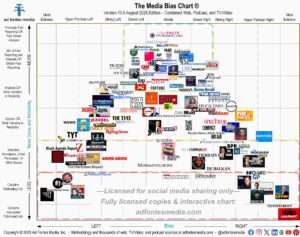
Break Out of Your Information Bubble
Author:
Beth Heldebrandt
Date:
11/12/2024
The election is over, and there’s much debate about how our information ecosystem may have affected how people voted — whether that be in the presidential race, Senate or Congressional seats, or state ballot measures about abortion or other policies.
Here at Ad Fontes Media, we recommend that people actively pursue various sources of information in order to prevent being trapped inside an information bubble. We all know that our online viewing habits — especially on social media — affect the algorithms so that once you click on an article to read or a video to watch, you will then be continuously directed back to articles and videos similar in bias and topic to the one you originally clicked.
That’s what we mean by “information bubble.” Without realizing it and without any conscious choice by you, you are fed information online that reinforces the same ideas and viewpoints. The more you click, the more the algorithm feeds you the same stuff.
In order to break out of this information bubble, you have to choose to be active and not passive. Don’t just read whatever is fed to you organically online. You have to actively seek out other sources of information by going to websites you wouldn’t typically see, turning the channel to watch news programs you wouldn’t normally watch, or listening to a podcast you haven’t heard before.
This isn’t an easy habit to develop, and Ad Fontes Media is here to help. Our regularly published Media Bias Charts® show a variety of information sources from across the political spectrum. Use these charts as a guide to seek out media that is new to you.
Today we’re releasing the November version of the Web/Print Media Bias Chart® (stay tuned next week for the monthly podcast/audio chart, followed by the TV/video chart). Look closely at the web chart and try this: choose a source on the left side of the chart, a source on the right, and one from the top middle. Watch these three websites for a few days and see if you can detect the difference in what they’re reporting and how they’re reporting on it.
This is the best way to break out of your information bubble and read what other people who are different from you politically are reading. In the sources from the top middle you should find much more fact-based reporting, with little opinion or analysis. The ones on the left and right will likely include some language, headlines or photos that indicate a bias.
This is a fun exercise to do on your own, but you can also follow along on the Topics of the Week on our website. Each week we choose two stories from the news (one “starter” topic and one that’s more “advanced”) and examine how six different media outlets covered the same story. It can be eye-opening to see the difference.
The November Web/Print Media Bias Chart® includes 122 of the more than 2,500 websites our analyst team has rated. We choose a selection of sources to include on each month’s chart because it’s impossible to put all of them in a single image (the logos would overlap, and the result would be an image that is impossible to read). A list of the 122 sources included this month is available on our website.
Eight sources make their debut on this month’s chart:
- AZ Mirror
- GZERO Media
- Health Feedback
- Middle East Eye
- Prison Legal News
- Reclaim the Net
- Taki’s Magazine
- Texas Scorecard
Don’t see your favorite source on this month’s chart? You can search for it by using the Interactive Media Bias Chart® on the website or on the mobile app available for iPhone or Android. It’s free, but there are limits in terms of how many searches you can conduct per day and/or how much source data you can access. To get expanded access, you’ll need a News Nerd subscription. And to access ALL of it, you’ll need a News Nerd Pro subscription. Check out our subscription options here.
Want to stay informed on all of our work? Sign up for our free biweekly email newsletter!


